How to Translate on StoryWeaver
Posted by Remya Padmadas on April 15, 2020Here's a step-by-step guide on how to use the Translate tool on StoryWeaver:
1. Login to your StoryWeaver account using your email ID and password. If you don’t already have an account, sign up here. A confirmation email will be sent to the email ID you have used to sign up. Please confirm your account to complete the sign up process.

2. Click on the Translate tab on the StoryWeaver homepage. Select the language you would like to translate to. Remember to translate the story in the language with which you are most familiar with or in the language in which you think and feel! The stories that come up will be the ones that do not have translations in your chosen language.
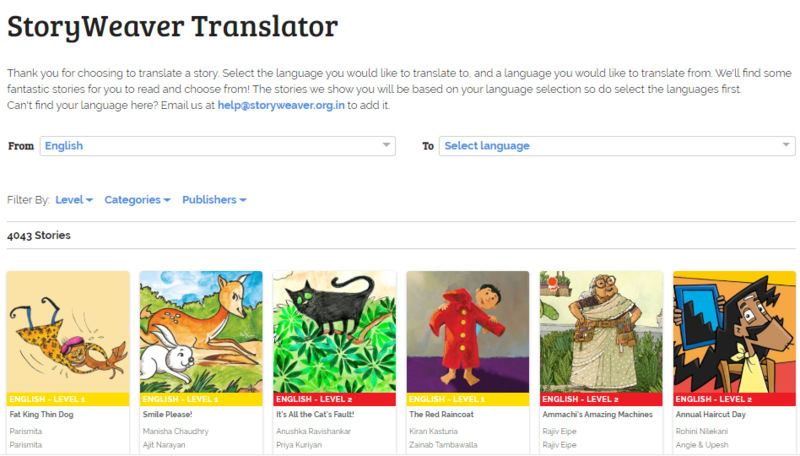
3. Selecting a story for translation
- You can narrow your story choices by using filters like Reading Levels (who are you translating the story for), Categories (what kind of stories are you looking for) etc. Browse through the selected stories and pick the one you would like to translate.
- Once you have selected the story, we suggest you read the story a few times before you begin translating. You can do this by hovering the mouse on the story card, clicking on the 3 dot menu and selecting the 'Read Story' option from here.
- After you have read the story, click on the TRANSLATE button on the story card.
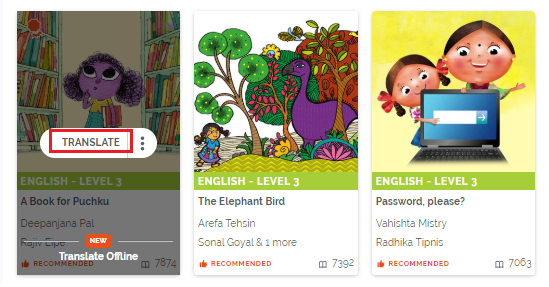
4. Setting up the translation draft
- The story will now open in the Story Editor along with the original text on the left hand page as a reference for you while translating. This reference text does not get published.
- The Tips button at the top will give you handy tips and best practises in translating children’s picture books.
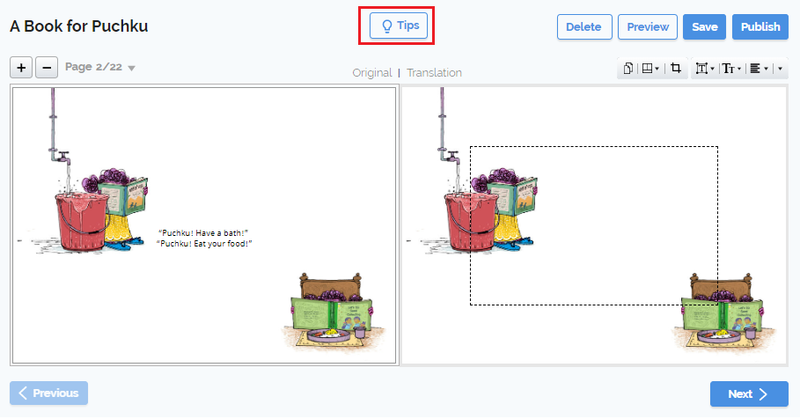
- To know more about the translation process, check out our Translate Tutorial or read the answers to Frequently Asked Questions about translation. You can also find some great translation tips here.
- You can save your translation and find it under ‘My Drafts’ in your Dashboard.

- You can now translate without using the internet. To know more about our new Offline Translate feature, click here.
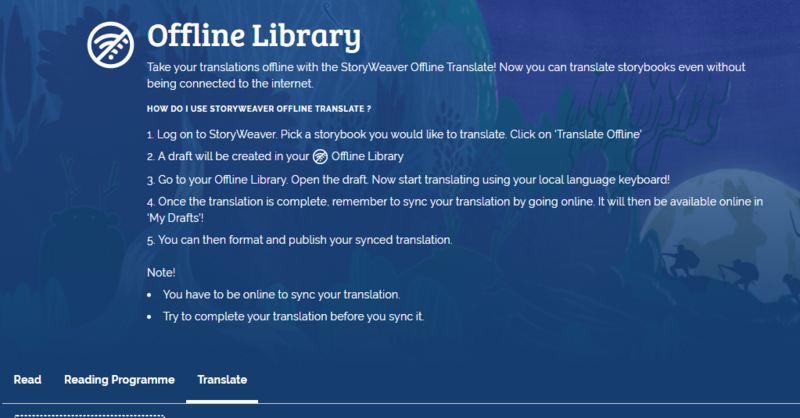
5. Start translating
You can add your translation in the Story Editor window on the right side. Please note that only Unicode fonts work on StoryWeaver as it's a universally accepted standard display of font.
- You can type using the language keyboard on your machine or start translating the text phonetically in the text box. For example, you can type "namaste" in English to get "नमस्ते" in Hindi, which sounds like "Namaste". As you start typing the word in English, a list of possible transliterations will appear. Choose the one you want and press 'Enter'.
- StoryWeaver offers transliteration support for 12 languages and dictionary support in over 100 languages to help with choosing the right form of the word in the translation.
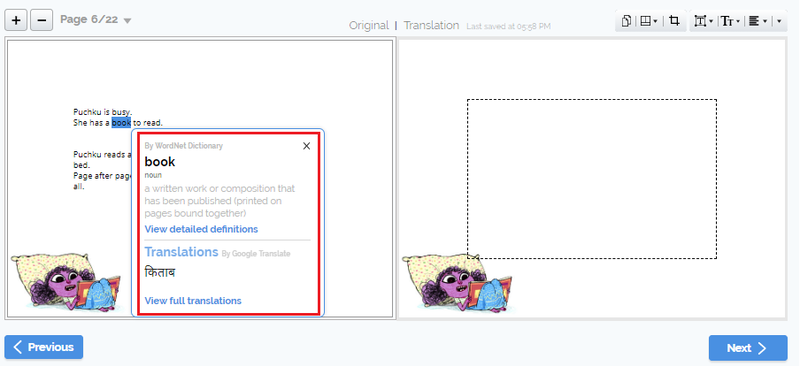
- If your chosen language does not have transliteration support, we recommend that you use Google Input tools. From Google Input tools, you can just copy & paste the translated text into StoryWeaver.
6. Formatting your translation
- You can change alignment, text size and text style using the formatting options in the editor. For better readability, we recommend matching these to the style, size and alignment used for the original text (on the left hand page).
- You can add a duplicate page if the translated text does not fit into the text box (dotted lines). The duplicate page can hold the remaining text.
7. Getting ready to publish
- We recommended previewing your draft before you publish (from the Preview button in the editor).
- Hit the Publish button when you are ready.
- This will open the Publish form. Fill in all the details, including the translation of the synopsis in the form before clicking 'Publish'.
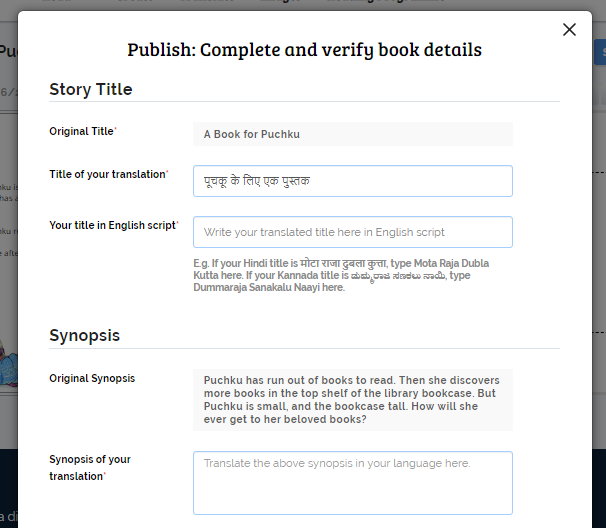
- Your story will appear in ‘New Arrivals’ shortly.
8. Share your work, build your profile
- You can share your translation on social media so that others can enjoy it too. You can click on the Share button from the Story Details page of your story and share your story on WhatsApp, FaceBook or Twitter.
- Lastly, don’t forget to update your profile page by adding a few lines about yourself, a profile picture and contact info (email ID/ social handles, if any) in the ‘My Details’ section of your Dashboard.
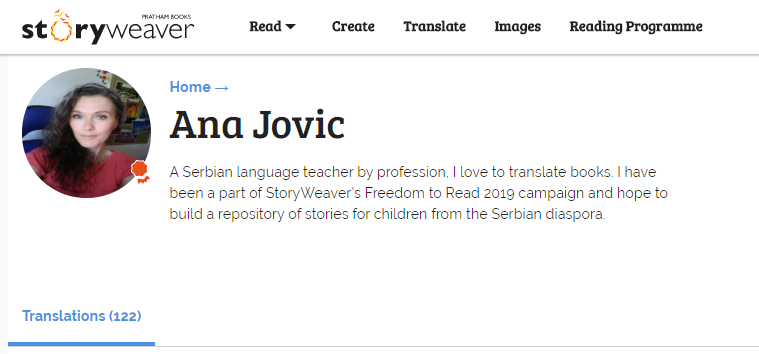
If you have any questions or are facing any issues, please write to us at [email protected]
Leave your thoughts in the comments section below! You can also reach out to us through our social media channels: Facebook, Twitter and Instagram.
comment (1)StoryWeaver Spotlight: Utthana Bharighat
Posted by Remya Padmadas on September 29, 2018
Utthana Bharighat is an artist who likes to create narratives and has a deep interest in theatre, cinema and writing. He has translated books to Kannada for Pratham Books, adding translator to his accomplishments.
 Q: What type of person do you think makes the best translator for children’s stories?
Q: What type of person do you think makes the best translator for children’s stories?
Most importantly, the person should love children. A good translator is someone who is ready to interact with children unconditionally, and thus he or she understands their lingo and temperament well.
Q: Do you have any advice for anyone interested in becoming a translator?
Do it only if you find it fun! Otherwise translation could be boring and mechanical which shows up in your work too.
Q: A book you'd like to recommend to other translators?
There is a Kannada language translation of the Japanese novel Thousand Cranes by Yasunari Kawabata, by the name Savira Pakshigalu. I would recommend people to read both these texts to see how beautiful a translation can be. The Kannada translation is as elegant as the original.
Q: What is your personal relationship to language and/or translation?
Translation at one level is like solving puzzles. But to solve this, one has to take help from wide range of knowledge systems, including literature, culture, sociology, human nature and more. Thus, translation becomes an extension of exploring my interest.
Q: When you’ve been given a story to translate, what’s your process, and how long does it generally take?
A: I read the whole story, first. Then I think about the style in which this would sound good in Kannada. After that, I read every sentence and try to find words which suit the style. After finishing the whole story, I will read it again and make further changes. To do all this it would take 3 to 4 hours for me.
Q: What do stories in translation bring to young readers?
A: Some stories ignite children’s imagination. Some stories give them an access to a different world that they have never seen before. Along with learning new things children will learn new words and thus improve their language skills.
Q: You’ve translated stories for us. Which has been your favourite to work on?
A: I liked The Red Fairy and Stage Fright.

Q:. What is the hardest thing about translating from English into Kannada? How do you navigate words or phrases that are tricky to translate?
A:Whenever I encounter tricky phrases or sentences, I imagine myself explaining this to a child in Kannada. As I do it a few times, I will arrive at a solution. Sometime asking people around for suggestion also helps.
Q: How do you feel when your story reaches the child?
A: Of course, it is the most beautiful feeling. And I always hope that the child likes what he/she reads.
Q: As a Student of Performance arts, what do you think is the best approach to translate children's stories? And, do you think you have found a way in this regard?
A: I can’t say I have mastered it. But I am gaining skills as I do it more and more. I would say. Performance arts have taught me how to communicate in a simple and clear manner. I think these two qualities are important for translation too.
Q: How else do you think we can join hands to take more stories to more children in more languages?
A: I would like to see more of local stories. Though there is universality in the themes and interests, I feel that the children gain more if they are given the stories which have taken form in their own cultural space. I think there is more to gain if some decentralization happens in the creation of stories and illustrations, which are being featured here. Regardless of the competent translators, a Kannada story teller would reach a Kannada kid in a more effective way. It is as organic as it could get.
Be the first to comment.
Spreading the net to find new writing talent
Posted by Remya Padmadas on May 23, 2018In the last year Pratham Books’ StoryWeaver platform has scaled up its offering of joyful multilingual books for children. One of our content streams headed by Bijal Vachharajani is creating 50 brand new books every year. “It's a tall task, one as gigantic as Hagrid!” shared the Potterhead. “Conversations with Outreach partners told us that we needed more engaging level 1 picture books to take to the youngest children. We also wanted to find new writers to work with.”
The editorial team was wondering how they could reach out to new authors who could write Level 1 picture books that used sound and action, which are always popular with young readers and educators alike. That's when wedecided to reach out to the children's theatre community. After all, who better to collaborate with than professionals who have spent much of their career writing, directing and acting in plays for children?

The venue for the workshop was the wonderful Bhau Daji Lad Museum, Mumbai.
Pratham Books Editor Shinibali Mitra Saigal, one of the founders of Kahani Karnival, reached out to her extensive network of writers in theatre. She also stepped in to curate the workshop.
“I think it's important to spread the net when trying to catch new writing talent. By focusing our attention on people with a specialised set of skills, and then guide them to picture book creating, we can make books that use their skills. In this case, it was a strong connection to what children find exciting and a good sense of sound, action, dialogue and dynamic storytelling” said Shinibali who kept in mind diverse skill-sets and an ability to accept feedback and change when choosing particpants. Shinibali’s handpicked group included a perfect blend of people like Sananda, Timira and Preeti who had created plays and scripts in schools for years and who were also very well-versed with picture books.
Authors like Neha Singh and Chatura Rao (winner of the The Hindu Good Books Best Picture Books award 2018) and playwrights like Akshat Nigam who recently won the Hindu best playwright award along with a colleague. Much loved theatre group Gillo Gilehri was represented by Janit and Yashoda. Actor and theatre instructor Lovleen Misra who has a rich background in theatre and television brought her own unique flavour to sessions. Bilingual Shawn Lewis is a strong believer in the idea that sounds rule a script while Shivani Tibrewal who has been teaching children to create scripts and plays loves the idea of whimsy.
Author Chatura Rao was keen to attend the workshop as “Workshops like this help a lot in peer-exchange of ideas.”
Over one-and-a-half days, in the leafy environs of Bhau Daji Lad Museum, a team comprising of Bijal, Shinibali and Assistant Editor Aparna Kapur deconstructed picture books for the participants of the workshop and played games to understand ideas of children's narrative. One of the activities asked the group to split into teams and prioritise what they felt was important in a picture book, using chits of paper that had pre-written statements like ‘A picture is worth a thousand words’ and ‘Picture books should not talk about death, depression and sex’. The teams then had to explain why they chose to order the statements as they had.
Participants talk about writing for children:
Masterclass
The workshop also had the privilege of hosting two amazing picture book creators: prolific author Natasha Sharma and illustrator Tanvi Bhat dropped in to talk to the participants about the finer nuances of writing and illustrating picture books.
“The idea to invite Natasha Sharma for the workshop was very clear. Natasha has written a bunch of books for children which elicit a great deal of excitement and joy. Having attending a number of her sessions, I have seen the queries and the laughter elicited by her books.” said Shinibali. “During her session Natasha took all the participants through the creation of a book. She shared her process and was honest about the things that have worked and have not. She also spoke about how she has evolved as a picture book writer over the years. She stressed on the importance of brevity and cautioned writers against running away with words, and letting the illustrations do the talking. I think that was a very illuminating point for most first-time writers.”
As playwrights, the participants understood the writing process but many of them didn't know what happened to their story once they had written in. Tanvi’s session then looked at the same process of creating books for children but through the lens of an illustrator.
”While making picture books, writers and illustrators are co-creators, so getting an illustrator to talk to the participants was essential. In addition to explaining her own process, Tanvi went into the details of how an illustrator would approach a project in circumstances in which she's involved from the beginning versus one where she receives a complete manuscript, how an illustrator deals with detailed visual notes from the author versus none at all.” Aparna shared.
Tanvi answered the writer’s questions on how involved writers could and should be during this part of book creation, how much of their characters' final look they could imagine, and how the text sometimes has to change once the illustrations are done.
Writing time
Before the workshop began, all the participants were sent a list of themes and ideas to think of potential story ideas around. Post lunch on day 1, the writers shared their story ideas with the group and editors. Their homework for the evening was to take on board the feedback they’d received and write a first draft.
Lovleen Misra’s poetry had the group laughing and sighing in equal measure.
Day two started with each participant taking their first draft to an editor for a one-on-one feedback session. This soon morphed into a freewheeling discussion with small groups sitting under the trees that are spread across Bhau Daji Lad Museum’s courtyard.
Hello Kids!
Sure the writing was great, the coffee was good and the lunch was amazing - but the real highlight of the workshop was when the kids arrived! One hundred feisty, energy-filled kindergarteners from the Sai Baba Path School, Parel brightened up the afternoon with their presence. The kids were there to listen to the authors narrate their ideas which was the real litmus test for their work! Each author took on a group of students, and regaled them with songs, activities and of course, stories!
The workshop wound up with a quick recap of what would happen next, before we bid adieu to the writers, excited about the prospect of fresh stories arriving in our inboxes!
Aparna admitted that her initial apprehensions about the workshop had disappeared. “I was tentative about the workshop because it was the first time we were experimenting with such a format. But at the end of the two days, I was delighted! We'd met a group of people, both smart and humble. They were keen to learn a new skill, and understood what children enjoy, better than most people do.”
“We managed to bring together a bunch of whimsical, creative and slightly off-kilter people who love children and get them to create words\ideas that children will love.” said Shinibali.
We’ve been receiving scripts every day and are confident that we have some real winners on our hands.
Here's a quick look at what happened over the two day workshop.
Be the first to comment.